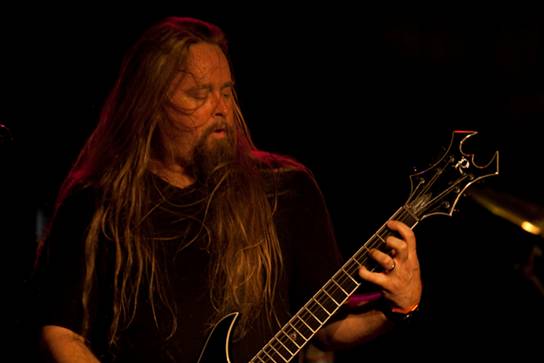What a Difference a Phrase Makes, Part 2

For the full tabs for the music discussed in this column, download the PDF here.
Hey all, we’re back in full swing here again! Since the last column, the Omega Wave Over The World Tour has continued, with the Bay Area Metal Festival in San Jose, California, a stop over to record the first in my artist series instructional videos for JamPlay.com, the Tuska Festival in Helsinki, Finland, then on to Australia for a 6 date tour. Next up is our first headlining tour of Europe, a 16 city tour that is the first full European leg in support of the tour this year.
In the last column, I talked about the importance of phrasing and how being aware of certain aspects in phrasing -- chord tones, tone, vibrato and other dynamics -- can embellish your phrasing, and hopefully cause it to stand out stronger than before. In this column, I will explore this concept further, showing you how you can add more color to your phrasing with extended notes and demonstrate various technical approaches I use to take my phrasing further. I will take you through some of my past and present material as examples of these concepts and ideas, and point you towards a few ways to better realize how to apply these concepts in your own works.
I have heard many times over the last six years how many people revere the Nevermore album This Godless Endeavor and how much they admire the work that everyone in Nevermore at the time put into this album. Most of all, I get a lot of compliments on my solos from the album, which I still find very humbling! I am very happy to share my guitar solo from the title track, which occurs just after the first pre-chorus.
First off, let’s take a look at the progression underneath, to understand what is at play here (see Ex.1). The chord progression is essentially two chords - both are 2nd inversion Dmin/A, and E/B chords, and are the iv and V chords in the A harmonic minor key.
In the first phrase ( Ex.2,measures 5&6), I start from the 9 (E), and play the 3rd and root after passing through this note. I have always preferred playing something other than a root, 3rd, or 5th, to open a phrase in a solo. I find it creates suspense, kind of lends a feeling of uneasiness and anticipation, setting the stage for what will happen next.
In the second phrase (Ex. 2 measures 7-9), I build a Dmin9 arpeggio, finishing with a descending harmonic minor run that starts from G#, the 3rd of E, and finishes on the tone an octave lower. I play this run as a legato line, my usual preference when playing faster runs, as I have always liked that slippery sound you can get from playing legato.
All the latest guitar news, interviews, lessons, reviews, deals and more, direct to your inbox!
For the third phrase (Ex. 2measures 9&10), I repeat the theme I established in the first phrase, just an octave higher. The beginning of this phrase is rhythmically displaced as well, anticipated on the “and” of 4 in the previous bar.
I wrap up the section with a final phrase (Ex.2 measures 11-14), playing essentially a descending Dmin7 arpeggio, but with a twist; to begin this phrase, I start with a #6. I start the phrase from the “B” note on the Hi E string (19th fret), go up to the 7th, “C” (20th fret), then descend the arpeggio down to the 7th two octaves below, and ascend back through to the 7TH two octaves higher, then finish at “B”. The “B” note falls right on the E chord in the next bar, and I finish with a descending hammer on lick, then travel to the “E” note on the B string, bend it up to “F”, and finish with the note “D”, the root. I use sweep picking throughout the phrase, another legato technique that I love to use not only for arpeggios, but also single note lines as well.
At the end of the phrase, I chose to ornament the last bits of the phrase with a hammer-on pull-off lick that goes right into the “G#”, the 3rd the E chord, and also bend the “E” note (9th) up a half-step to “F” (3rd) and back, ending on “D”,. the root of the next chord, which finds us back in the pre-chorus of the song again.
I like to spice up my phrasing by playing on the off beats, rather than have everything always falling right on the beat. It is my feeling that this lends more “breath” and life to a phrase, rather than just keeping it “on the beat” all the time.
To work this approach into your playing effectively, set a metronome to a comfortable tempo (e.g.80bpm), then play a droning note, say Lo E for instance. Alternatively, if you have a keyboard, you might play a drone from this instead. While all of this is happening, listen to the beat, and consciously improvise from the off-beat, starting and ending your phrases from off-beats. Given time, this will become easier, and should come more naturally as part of your phrasing vocabulary. I highly suggest recording these improv sessions, in order to listen to how you’re approaching your phrasing, and also to catalog any cool licks as well! Have a listen to some of your favorite players, and see where they start their phrases; is it on the beat, or off the beat, and where off the beat do their phrase fall? I believe inspiration in this area breeds as many good ideas as there are guitar solos out there, so have fun exploring this!
The next example I’ll show you is from the Dragonlord song, “Judgement Failed."
Let’s take a look at the chord progression underneath the solo riff (Ex.3). On first listen, it sounds busy. It’s a single line phrase, descending C# minor scale, and following this, a B minor ascending phrase, then a B Phrygian dominant scale descending. A closer look shows that this single line phrase is essentially two chords: a C# minor and a B5 chord.
When I first heard this phrase, it reminded me of an Iron Maiden type of riff, but with a twist, so I decided to channel my inner Adrian Smith for this one! Yet, I also wanted something more contrapuntal in nature, so as the playback was happening, I came up with a plan…
In the first phrase (Ex.4,measure 18), I play a C#m add 9 arpeggio, climbing to the 7th, then descending back through the minor scale. I was careful to avoid playing over the last part of the riff, instead playing a trill to end the phrase, while the riff finished it’s first cycle.
Next, I wanted to play a descending line in C# minor, but my mind went to a different place, and the end result being a string skipping phrase across the G and Hi E strings (Ex.4, measures 19-20).
The chord change happened next, and I went into improve mode a little more here, playing a line that was part contrary motion, then oblique, finishing with a parallel line that harmonizes the rhythm, and a held note (C#) as the chord changes back to C# minor (Ex.4, measure 20).
My next phrases (Ex.4,measures 21-23) were where I feel my “inner Adrian” came out to jam for a bit, as I played with a more bluesy approach here, a few double stops from the root kicking it all off. I followed this phrase with a “question” phrase; where I feel like I am asking a question with my phrasing. I play a few unison bends (root, octave, then third of C#), following with an “answering” phrase, a descending line in C# minor, from the 4, the last phrase in this series, a bend on G# that finishes at B, the 7th of C#, but also the root of the next chord.
The B carries over into the last cycle of the B phrase (Ex.4 measure 24), after which I follow with an offbeat phrase of D# and E notes. Next, I play a descending line from the 5th to the 7th below the octave. The entire phrase is meant to recall the contrapuntal lines I was playing earlier, and draw us towards a close.
In my last phrase (Ex.4 measures 25-26), I play a series of double stops in 6ths across the G and Hi E strings, sequenced in 3rds. The effect I believe one can get from playing 6ths in this manner, is one of a staggered yet almost chordal type of phrase as well. To my ear, the top of the line (notes: E,C#,D#,B,C#) are staggered on the beat and off the beat, back and forth, finishing with the final C# not being held to the end. The bottom notes in the phrase (G#,E,F#,D#,E) have a doubling effect, with each note being played twice as I play each double stop.
In my next column, we’ll wrap up with a look at two of my favorite phrases from Forbidden’s Omega Wave album, and offer a perspective on furthering this approach. See you next time!
